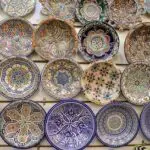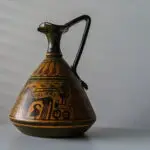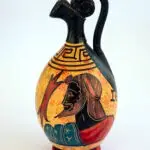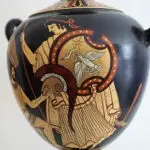Contemporary Mediterranean pottery is a broad term that encompasses a wide range of styles, techniques, and aesthetics. The art of ceramics began in the Mediterranean region thousands of years ago, and it has since evolved and adapted to modern times. Today, contemporary Mediterranean pottery artists draw inspiration from the rich history and culture of the region, and they combine traditional techniques with innovative approaches to create unique and beautiful pieces.
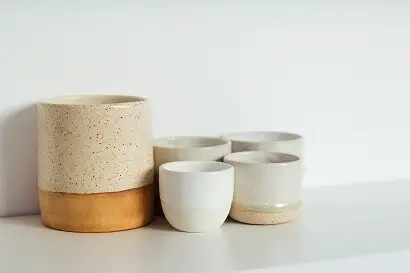
One of the key elements of modern Mediterranean pottery is its design aesthetic. Many artists draw inspiration from the natural beauty of the region, such as the warm hues of the olive groves, the vibrant colors of the Mediterranean Sea, and the rustic elegance of simpler times. They combine these elements with modern techniques and materials to create pieces that are both timeless and contemporary. Whether it’s a vase, a plate, or a decorative object, contemporary Mediterranean pottery celebrates the rich cultural heritage of the region while also embracing innovation and creativity.
Key Takeaways
- Contemporary Mediterranean pottery draws inspiration from the rich history and culture of the region.
- Artists combine traditional techniques with innovative approaches to create unique and beautiful pieces.
- The design aesthetic of contemporary Mediterranean pottery celebrates the natural beauty of the region while also embracing modern techniques and materials.
Evolution of Mediterranean Pottery
Mediterranean pottery has a rich and diverse history that spans millennia. From the Classical period of Greece and Rome to the present day, Mediterranean pottery has evolved and adapted to reflect the changing cultural, social, and economic landscape of the region.
Historical Overview
The history of Mediterranean pottery can be traced back to ancient civilizations such as the Greeks, Romans, and Phoenicians, who used pottery for a variety of purposes, including cooking, storage, and decoration. The use of clay, terracotta, and earthenware was widespread throughout Italy and the Mediterranean, and the development of new techniques and styles was influenced by trade and cultural exchange.
Influence of Mythology and Folklore
Classical myths and folklore have had a significant impact on the evolution of Mediterranean pottery. Depictions of animals, demons, and other mythical creatures were common motifs in pottery designs, and many of these designs were imbued with symbolic meaning. For example, the use of cobalt blue in pottery was thought to ward off evil spirits, while copper and gold were used to create intricate patterns and designs.
Impact of Women in Mediterranean Pottery
Women have played a pivotal role in the development of Mediterranean pottery, both as makers and as subjects of the artwork. In many cultures, women were responsible for creating pottery for everyday use, and their designs often reflected their experiences and perspectives. Women were also frequently depicted in pottery designs, often in traditional roles such as mothers, wives, and daughters.
Colonialism and Mediterranean Pottery
The impact of colonialism on Mediterranean pottery cannot be understated. The colonization of the region by various European powers led to the introduction of new techniques and styles, as well as the exploitation of local resources and labor. The Massier family in France is an example of a family who revolutionized Mediterranean pottery by introducing new techniques and designs. They were able to work with famous artists such as Picasso to create unique pieces that were highly sought after.
In conclusion, the evolution of Mediterranean pottery is a reflection of the region’s rich cultural heritage and its ongoing transformation. From the Classical period to the present day, pottery has been an essential part of Mediterranean life, and its influence can be seen in art, design, and everyday objects.
Current Trends in Mediterranean Pottery
Contemporary Mediterranean pottery has evolved over time to incorporate new styles and designs that reflect the changing tastes and preferences of consumers. This section explores some of the current trends in Mediterranean pottery, including contemporary styles and designs, the international influence on Mediterranean pottery, studio pottery and tableware, and vintage Mediterranean pottery.
Contemporary Styles and Designs
Contemporary Mediterranean pottery has seen a shift towards more modern and minimalist designs that incorporate simple shapes and muted colors. This trend is reflected in the use of neutral tones such as brown, white, and beige, as well as the use of porcelain and other materials that provide a smooth texture and clean lines.
One of the key elements of contemporary Mediterranean pottery is the balance between simplicity and complexity. While the designs are simple, they often incorporate intricate patterns and decorations that add depth and interest to the piece.
International Influence on Mediterranean Pottery
The international market has had a significant influence on contemporary Mediterranean pottery. Designers and craftsmen have been inspired by the pottery and ceramics of other cultures, resulting in a fusion of styles and techniques that create unique and innovative pieces.
The use of elements such as doors and tiles in Mediterranean pottery is a reflection of the international influence on the craft. These elements add a touch of individuality and character to the pieces, making them stand out in a crowded market.
Studio Pottery and Tableware
Studio pottery and tableware have become increasingly popular in contemporary Mediterranean pottery. These pieces are often handmade and crafted with care, reflecting the artisanal craftsmanship that is synonymous with Mediterranean pottery.
The use of texture and pattern in studio pottery and tableware adds depth and interest to the pieces, making them both functional and decorative. These pieces are often sold in specialty shops and online marketplaces, catering to a niche market of consumers looking for unique and high-quality pottery.
Vintage Mediterranean Pottery
Vintage Mediterranean pottery has also seen a resurgence in popularity in recent years. These pieces are often sourced from antique stores and flea markets, providing a glimpse into the rich history and tradition of Mediterranean pottery.
Vintage Mediterranean pottery often incorporates bold colors and intricate patterns, reflecting the vibrant culture and heritage of the Mediterranean region. These pieces are highly sought after by collectors and enthusiasts and are often used as decorative pieces in homes and businesses.
In conclusion, contemporary Mediterranean pottery has seen a shift towards more modern and minimalist designs, while still incorporating intricate patterns and decoration. The international market has had a significant influence on the craft, resulting in a fusion of styles and techniques. Studio pottery and tableware have become increasingly popular, catering to a niche market of consumers looking for unique and high-quality pottery. Furthermore, the display of Mediterranean pottery in museums helps preserve its cultural heritage and allows visitors to appreciate its beauty and craftsmanship. Finally, vintage Mediterranean pottery has seen a resurgence in popularity, providing a glimpse into the rich history and tradition of Mediterranean pottery.
Innovative Approaches in Mediterranean Pottery
Mediterranean pottery is known for its unique designs and patterns that have been developed over centuries. However, contemporary Mediterranean pottery has seen a resurgence in recent years with artists exploring new techniques and materials.
New Techniques and Materials
Innovative approaches in Mediterranean pottery have led to the use of new techniques and materials. For example, some artists are using terracotta and white clay to create intricate designs and patterns. Others are experimenting with cobalt, copper, and gold to add a metallic finish to their pottery.
In addition, some artists are using molds to create unique shapes and forms that were not possible before. This has led to the creation of sculptural ceramic vessels and ewers that are both functional and decorative.
Emerging Artists in Mediterranean Pottery
There are many emerging artists in Mediterranean pottery who are pushing the boundaries of traditional techniques and designs. These artists are experimenting with new materials and techniques to create unique and innovative pieces.
One such artist is Paris-based ceramicist, Marie Laurent. She uses a variety of surface decoration techniques such as sgraffito and slip trailing to create intricate designs on her pottery. Her work has gained popularity on social media and has been featured in several exhibitions.
Mediterranean Pottery on Etsy
Etsy has become a popular platform for artists to sell their Mediterranean pottery. There are many shops on Etsy that specialize in Mediterranean pottery, offering a wide range of designs and styles.
One such shop is AlisonRyczek, which offers a range of handcrafted pottery bowls and plates. The shop’s owner, Alison, uses traditional techniques such as hand-building and wheel-throwing to create unique pieces.
In conclusion, innovative approaches in Mediterranean (interior) pottery have led to the use of new techniques and materials, the emergence of new artists, and the availability of Mediterranean pottery on popular platforms such as Etsy. These developments have breathed new life into the ancient art of Mediterranean pottery, making it more accessible and appealing to a wider audience.
Notable Contemporary Mediterranean Pottery Artists
Contemporary Mediterranean pottery artists are known for their unique and innovative designs, which combine traditional techniques with modern aesthetics. This section explores some of the most notable Mediterranean pottery artists, highlighting their contributions to the field of contemporary ceramics.
Ceramic Sculptures
One of the most prominent contemporary Mediterranean pottery artists is Italian ceramicist, Giuseppe Penone. His work combines traditional ceramic techniques with modern sculptural forms, resulting in stunning pieces that are both functional and aesthetically pleasing. Penone’s work often features intricate patterns and designs, as well as organic shapes and forms inspired by nature.
Surface Decoration and Patterns
Another notable contemporary Mediterranean pottery artist is Spanish ceramicist, Carmen F. Tena. Tena’s work is characterized by its intricate surface decoration and patterns, which are inspired by traditional Mediterranean motifs and designs. Her tableware and cooking vessels are particularly popular, with their bold colors and intricate patterns adding a touch of Mediterranean flair to any kitchen.
Cultural and Mythological Influences
Many contemporary Mediterranean pottery artists draw inspiration from the rich cultural and mythological heritage of the region. Greek ceramicist, Athanasios Argianas, is known for his pieces that are inspired by ancient Greek myths and legends. His work often features intricate depictions of mythical creatures, such as demons and animals, as well as traditional Greek patterns and motifs.
In conclusion, contemporary Mediterranean pottery artists are known for their unique and innovative designs, which combine traditional techniques with modern aesthetics. From ceramic sculptures to surface decoration and patterns, these artists draw inspiration from a variety of sources, including traditional Mediterranean motifs and designs, as well as cultural and mythological influences.
Cultural and Global Influences
Mediterranean pottery has a rich history and has been influenced by various cultures and traditions. The pottery is not only a reflection of the region’s culture but also of its interaction with other cultures across the globe.
The pottery of the Mediterranean region has been shaped by a variety of cultural influences. The region’s geography has played a significant role in shaping the pottery’s style and design. The pottery of the Mediterranean region is known for its intricate designs, vibrant colors, and unique shapes. The pottery has been influenced by the cultural traditions of the Phoenicians, Greeks, Romans, and Arabs, among others.
In addition to cultural influences, the pottery of the Mediterranean has also been shaped by global influences. The region’s pottery has been influenced by pottery styles from across the globe, including Asia, Africa, and Europe. The pottery of the Mediterranean region has been influenced by the pottery of India, which is known for its intricate designs and vibrant colors.
The pottery of the Mediterranean region has also been influenced by global trade. The region’s pottery has been traded across the globe for centuries, and this has led to the exchange of ideas and styles. The pottery of the Mediterranean region has been influenced by global trade with China, India, and other countries.
Overall, the pottery of the Mediterranean region is a reflection of the region’s culture and its interaction with other cultures across the globe. Pottery has been shaped by various cultural and global influences and continues to evolve to this day.
- The Top Restaurants Specializing in Truffle Dishes - August 10, 2023
- Truffle Panna Cotta: A Decadent Dessert Recipe for Truffle Lovers - August 7, 2023
- Truffle Scrambled Eggs: A Luxurious Breakfast Delight - August 7, 2023

